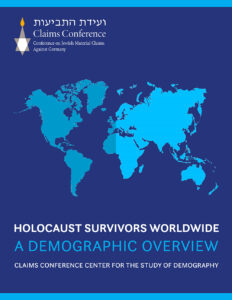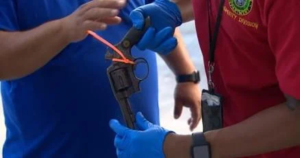Hundreds of
the world’s endangered
and threatened languages
are spoken
in and around New York City.
Videos by Ruven Afanador
Dots on the maps in this piece represent, among other things, efforts to revitalize a language as well as communities of speakers.
Most people think of endangered languages as far-flung or exotic, the opposite of cosmopolitan. “You go to some distant mountain or island, and you collect stories,” the linguist Ross Perlin says, describing a typical view of how such languages are studied. But of the 700 or so speakers of Seke, most of whom can be found in a cluster of villages in Nepal, more than 150 have lived in or around two apartment buildings in Brooklyn. Bishnupriya Manipuri, a minority language of Bangladesh and India, has become a minority language of Queens.
All told, there are more endangered languages in and around New York City than have ever existed anywhere else, says Perlin, who has spent 11 years trying to document them. And because most of the world’s languages are on a path to disappear within the next century, there will likely never be this many in any single place again.

Zenaida Cantu, 38, speaks Tlapanec, also known as Me’phaa, an Indigenous language spoken in Central Mexico. She works as an interpreter in New York City.
Ikhiil Mardakhayev, 80, speaks Juhuri, which has 100,000 to 200,000 speakers worldwide, mostly in Israel and the U.S. He teaches the language in Brooklyn.
Language loss has been a natural part of human history for centuries, but it was typically small in scale and relatively confined. The lost language could sometimes leave traces in the language that overtook it, what linguists have called a “grammatical merger” of intersecting societies.
About 30 years ago, though, the linguists Ken Hale and Michael Krauss warned of a new, more dire form of loss in which a dominant language would “simply overwhelm Indigenous, local languages and cultures.” Hundreds of languages were essentially gone, Krauss noted, and others were quickly fading. Several were spoken by as few as one or two people.
As Perlin writes in his new book — “Language City: The Fight to Preserve Endangered Mother Tongues in New York,” out this month — what stands to be lost is more than mere words. “Languages represent thousands of natural experiments: ways of seeing, understanding and living that should rightly form a major part of any meaningful account of what it is to be human.”
Eleanor Castillo Bullock, 65, is a founder and the arts director of Garifuna Arts Medicine Agriculture Education International, an organization that protects and promotes Garifuna heritage in Belize and New York City.
Gloria Angeles, 47, who goes by Tadii, is the founder of Rebeldía Radio, a community radio project. She speaks Cuicatec, or Dbaku, an Indigenous Latin American language that has around 10,000 speakers worldwide.
With Daniel Kaufman, also a linguist, Perlin directs the Endangered Language Alliance, in Manhattan. When E.L.A. was founded, in 2010, Perlin lived in the Chinese Himalayas, where he studied Trung, a language with no standard writing system, dictionary or codified grammar. (His work helped establish all three.) He spent most of his time in the valley where the largest group of remaining speakers lived; the only road in or out was impassable in winter.
After three years, Perlin returned to New York City, where he had grown up. At that time, E.L.A. conducted language surveys on foot, canvassing neighborhoods and posting fliers seeking speakers of endangered languages. Most of the work was directed by the organization’s founders: two linguists, including Kaufman, and a poet.
In 2016, E.L.A. began to map the languages spoken in the city. A vast majority were not recognized by large businesses, schools or city government. Officially, Perlin said, they were simply not there. “None of the communities with whom we planned to partner were recorded as even existing in the census,” Kaufman and Perlin later wrote.
Since their project began, Perlin and Kaufman have located speakers of more than 700 languages. Of those languages, at least 150 are listed as under significant threat in at least one of three major databases for the field. Perlin and Kaufman consider that figure to be conservative, and Perlin estimates that more than half of the languages they documented may be endangered.
Rasmina Gurung, 26, learned Seke from her grandmother. Until recently, she resided in one of two Brooklyn buildings where about a quarter of the people who speak the language worldwide have lived.
Safiyatou D., 44, lives on Roosevelt Island. According to E.L.A., she is the only known speaker of Kota, or Ikota, a language spoken in Gabon and the Republic of Congo, in the city. (She asked that her last name not be used, to protect her privacy.)
A language’s endangerment is not simply a function of its size but also a measure of its relationship to the societies around it. Sheer numbers “have always mattered less than intergenerational transmission,” Perlin writes in “Language City.” Until recently, in many regions of the world, dozens of languages lived side by side, each with no more than a few thousand speakers. Gurr-goni, an Aboriginal Australian language, had long been stable with 70. A language survives, Perlin writes, by sharing life with those who speak it: “Only in the face of intense political, economic, religious or social pressures do people stop passing on their mother tongues to children.”
When Perlin visited Seke-speaking Nepali villages in 2019 and 2023, he found that many of the people he wanted to speak with had left to find work. “Whole age groups were missing,” he says. Kaufman points to Mixtec, a group of Indigenous languages spoken in south-central Mexico, with 500,000 speakers. The differences in how the language is spoken from village to village can be “bigger than you find between French and Italian,” he said. “And there are villages where there are essentially no young people.” Their children are now born elsewhere — Culiacán, Mexico City, New York, Los Angeles. “500,000 speakers can disappear in a generation.”
Ibrahima Traore, 65, teaches N’Ko. The West African writing system serves to counter the dominance of colonial French and English. He lives in Montclair, N.J.
Husniya Khujamyorova lives in Midwood, Brooklyn, and works as a financial-software engineer. She has published children’s books in Wakhi and other endangered languages of the Pamir mountains in Central Asia.
Perlin studies languages for what they communicate both explicitly and indirectly. A language’s lexicon is not “just one word after another,” he writes in “Language City,” but a representation of the enduring preoccupations of a culture. Its rules of grammar are held together by invisible selections of what will be conveyed and what will be overlooked. It “requires speakers to mark out certain parts of reality and not others, however unconsciously.”
When Perlin and Kaufman document a language, they work alongside native speakers to transcribe and translate video interviews that are recorded locally and during trips to a language’s home region. (Perlin and Kaufman have helped produce some of the first dictionaries and grammars of these languages.) To document Seke, for example, Perlin works with Rasmina Gurung, a 26-year-old nurse who happens to be one of the youngest Seke speakers in the world. Most Seke speakers, about 500 people, live across five neighboring villages in northern Nepal, near Tibet. Though the villages are within walking distance, each has developed its own Seke dialect. Like many of the smaller languages of “traditional face-to-face societies,” Perlin writes, Seke has no “formal, all-purpose hello,” because villagers live among the same groups of people and rarely encounter a Seke-speaking stranger. Instead, a question — Where are you going? What are you doing? — would be more common.
When E.L.A. researchers travel to interview speakers in their home regions, they may begin with a list of common questions, but the conversations are often more free-form. “Whatever the speakers want to talk about the most, we always encourage that,” Gurung says. “We always want to understand the language better, but we need to understand where it came from, how it came to be. Whatever’s close to home.”
Irwin Sanchez, 45, is a chef at a taqueria in Rockefeller Center. He speaks Nahuatl, one of the most common Indigenous Mexican languages in New York.
Patricia Tarrant, 36, is the executive director of American Indian Community House, a Manhattan organization that serves the needs of Native Americans living in New York. She is one of about 50 speakers of Hidatsa.
As E.L.A. produced its first language maps, the institute’s work caught the eye of Thelma Carrillo, a research scientist in the city’s Health Department. Carrillo, who is part Zapotec, was working on a Latino health initiative, but the city had what Perlin and Kaufman found to be “no basic demographic information” on New Yorkers from Indigenous communities in Latin America, even though they have been migrating here in large numbers since the 1990s.
“We found ourselves in this odd position of being a conduit between the Indigenous Latin Americans of the city and the city agencies, because other organizations that work with them see them as Mexican or Guatemalan,” Kaufman says. “We’re working with their languages, which becomes extremely important when you need to communicate something to them.”

Uttam Singha, 53, founded the first publishing company to release books in Bishnupriya Manipuri in the United States. Singha lives in Jamaica Estates, Queens.

Jean James, 39, knew some Lummi from her childhood and began to learn the language more seriously during the pandemic. She works for the Staten Island Ferry.
By the start of the pandemic, the city had begun official outreach in nine Indigenous languages and recorded videos in several other endangered languages. By reaching these communities in their own languages, New York City offered what is almost certainly the first official recognition that they exist.
Still, Perlin and Kaufman are keenly aware that the corpus they are building — word by word and sometimes syllable by syllable — might someday turn out to be a kind of fossil record.
Outside of the office, Gurung mostly speaks Seke in voice notes to elders overseas or to tell her mother a secret she doesn’t want her sister to hear. On her first trip to Nepal with E.L.A., she ended every interview with the same question: “Do you think our language will survive?”
Methodology
The maps showing endangered languages in New York City are based on a map provided by the Endangered Language Alliance. We cross-referenced E.L.A.’s New York City language list with three independent databases that track the threat level of languages around the world: Ethnologue, which catalogs all known living languages in the world; UNESCO’s World Atlas of Languages, a survey of all the languages spoken in UNESCO member states; and the Endangered Languages Project, a site to which the public can contribute content, managed by the First Peoples’ Cultural Council and the Endangered Languages Catalogue (ELCat) project at the University of Hawaii at Manoa. Each of these projects determines how threatened a language is in a slightly different way. Criteria include the number of global speakers and whether multiple generations speak the language and are passing it on to the next. Additional languages were added in consultation with E.L.A.
The audio clips are excerpts from audio provided by E.L.A., which also provided the translations. In one instance, small adjustments to the translation were made to provide context that would have been clear to the speaker. The translation for Ibrahima Traore’s remarks comes from Coleman Donaldson.
Graphics by Francesco Muzzi.
Ruven Afanador is a Colombian-born photographer based in New York. He has worked on numerous portraits for the magazine, including Viola Davis, Denzel Washington, Jane Campion and Sharon Olds.
Alex Carp is a research editor at the magazine. He last wrote for the magazine about Steven Banks, the former Legal Aid lawyer who indirectly built much of New York City’s system of homeless shelters and services.




